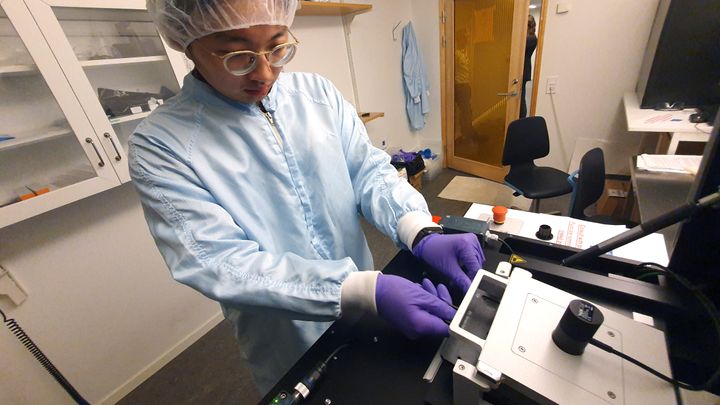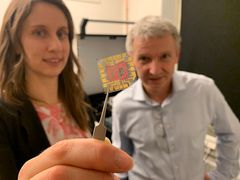Researchers hacked a 3D printer to speed up fabrication of bioelectronics
The speed of innovation in bioelectronics and critical sensors gets a new boost with the unveiling of a technique for fast-prototyping of devices.

A research team at KTH Royal Institute of Technology and Stockholm University reported a simple way to fabricate electrochemical transistors using a standard Nanoscribe 3D microprinter. Without cleanroom environments, solvents or chemicals, the researchers demonstrated that 3D microprinters can be hacked to laser print and micropattern semiconducting, conducting and insulating polymers.
Anna Herland , professor in Micro- and Nanosystems at KTH , says the printing of these polymers is a key step in prototyping new kinds of electrochemical transistors for medical implants, wearable electronics and biosensors.
The technique could replace time-consuming processes that require an expensive cleanroom environment. Nor would it involve solvents and developer baths that have a negative environmental impact, says the study’s co-author Erica Zeglio , a faculty researcher with Digital Futures , a research center jointly operated by KTH Royal Institute of Technology and Stockholm University.
“Current methods rely on expensive and unsustainable cleanroom practices,” Zeglio says. “The method we proposed here doesn’t.”
Polymers are core components of many bioelectronic and flexible electronic devices. The applications are diverse, including monitoring living tissues and cells and diagnosing diseases in point-of-care testing.
“Fast prototyping of these devices is time consuming and costly.” Herland says. “It hinders the widespread adoption of bioelectronic technologies.”
Using ultrafast laser pulses, the new method creates possibilities for the rapid prototyping and scaling of microscale devices for bioelectronics, says co-author and KTH Professor Frank Niklaus. The method could also be used for the patterning of other soft electronic devices, he says. The team applied the new method to fabricate complementary inverters and enzymatic glucose sensors.
Herland says the method could advance research in bioelectronic devices and significantly shorten the time-to-market.
“This also creates the possibility of replacing some of the current components with cheaper and more sustainable alternatives,” she says.
The researchers published their results in the journal Advanced Science.
Read the research paper
"Cleanroom-Free Direct Laser Micropatterning of Polymers for Organic Electrochemical Transistors in Logic Circuits and Glucose Biosensors", Advanced Science, https://doi.org/10.1002/advs.202307042
Images

Subscribe to releases from KTH Royal Institute of Technology
Subscribe to all the latest releases from KTH Royal Institute of Technology by registering your e-mail address below. You can unsubscribe at any time.
Latest releases from KTH Royal Institute of Technology
Leading academics call for extending, reframing Sustainable Development Goals17.6.2024 10:46:06 CEST | Press release
A group of leading academics are calling for the UN Sustainable Development Goals to be extended past their 2030 target date and updated with consideration for the impact of artificial intelligence (AI), and with more input from communities affected by the goals, among other recommendations.
1,000 times smaller than a grain of sand—glass sensors 3D-printed on optical fiber15.5.2024 15:06:46 CEST | Press release
In a first for communications, researchers in Sweden 3D printed silica glass micro-optics on the tips of optic fibers—surfaces as small as the cross section of a human hair. The advance could enable faster internet and improved connectivity, as well as innovations like smaller sensors and imaging systems.
Climate is one culprit in spread and growth of Middle East dust levels30.4.2024 08:49:52 CEST | Press release
Climate change is transforming dust storms—a natural phenomenon in the Middle East—into a more frequent and widespread threat to health and economies throughout the region, a new study shows.
Device improves stem cell generation and chance for accessible Alzheimer’s cell therapy24.4.2024 20:18:16 CEST | Press release
Researchers in Sweden say they have improved on a technique for converting regular skin cells into neural stem cells—an advance which they say helps close the gap for accessible personalized cell-based therapies for Alzheimer's and Parkinson's.
Global warming and plastic pollution entwined in vicious circle, report says19.3.2024 10:56:01 CET | Pressmeddelande
Typically viewed as unrelated problems, global warming and plastic pollution are instead inextricably trapped in a “vicious circle” where one feeds the other, researchers in Sweden report in Nature Communications. The mutually-reinforcing relationship escalates global warming, the degradation of materials, plastic waste and the leaching of toxic chemicals into the biosphere.
In our pressroom you can read all our latest releases, find our press contacts, images, documents and other relevant information about us.
Visit our pressroom